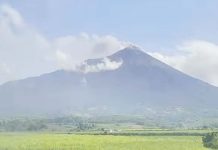 WHATEVER variety, banana remains one of the most popular fruits because it is available fresh all year-round and much cheaper compared to other tropical fruits.
WHATEVER variety, banana remains one of the most popular fruits because it is available fresh all year-round and much cheaper compared to other tropical fruits.
The volume of banana production in the country went up by 3.1 percent from 2.33 million metric tons for the period October to December 2016 to 2.41 million metric tons during the same period of 2017, based on a data from the Philippine Statistics Authority.
The increase can be attributed to additional bearing hills from the expansion areas of established banana plantations, due to the increasing demand, and bigger sizes of fruits developed resulting from less weather disturbances in some banana producing areas.
Davao Region was the biggest contributor to the total production with 37.4 percent or 901.53 thousand metric tons, followed by Northern Mindanao with 20.2 percent, and SOCCSKSARGEN (South Cotabato, Cotabato, Sultan Kudarat, Sarangani, and General Santos City) with 13.5 percent.
Data also showed that more than half or 51.4 percent of the total production of banana was from the Cavendish variety.
The increase in production can also be attributed to the bigger bunches harvested from the banana farms which have applied technologies and better inputs to improve their production.
Banana, particularly the Cavendish variety, requires intensive labor and better inputs to grow to a profitable volume.
One interesting to note is that banana is the most unique fruit because it does not come from trees, but from large plants that are giant herbs related to the lily and orchid families.
Incidence of erratic weather conditions affecting our country, like the El Niño and La Niña phenomenons, affected the growth of banana plants, causing yellowing of the leaves.
This weather condition causes production losses and deterioration of the banana plants, leading to poor quality of the fruit.
Damage to agricultural crops due to weather disturbances could be prevented or minimized with the proper application of farm inputs, like organic fertilizers and other related products.
On the other hand, bananas are classified either as dessert bananas or as green cooking bananas. It can be a delicious addition to fruit salads or peeled and eaten as it is.
According to the Food and Nutrition Research Institute of the Department of Science and Technology (DOST-FNRI), banana is a good source of fiber, vitamin C, and potassium.
Potassium is a mineral which is important for controlling the body’s fluid balance.
It is also needed for muscle contraction, transmission of nerve impulses, and the proper functioning of the heart and kidneys. Potassium helps to regulate water balance and blood pressure in cells, together with other minerals like sodium, calcium, and magnesium.
In general, bananas contain 400 milligrams of potassium. Most individuals receive approximately 2,000 to 3,000 milligrams of potassium from various foods.
Bananas are also rich in vitamins A, C, K, and B6, and in fiber and magnesium.
Lack of vitamin B6 in the diet can cause weakness, irritability, and insomnia.
Considering these great health benefits, the banana is truly a wonderful and delicious fruit, and affordable too. (jaypeeyap@ymail.com/PN)






